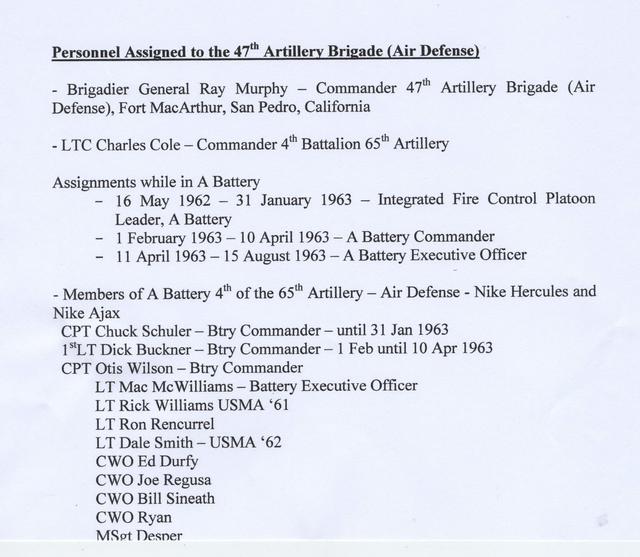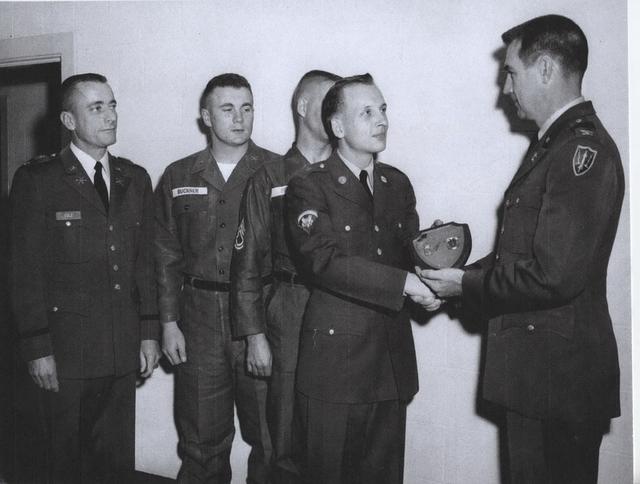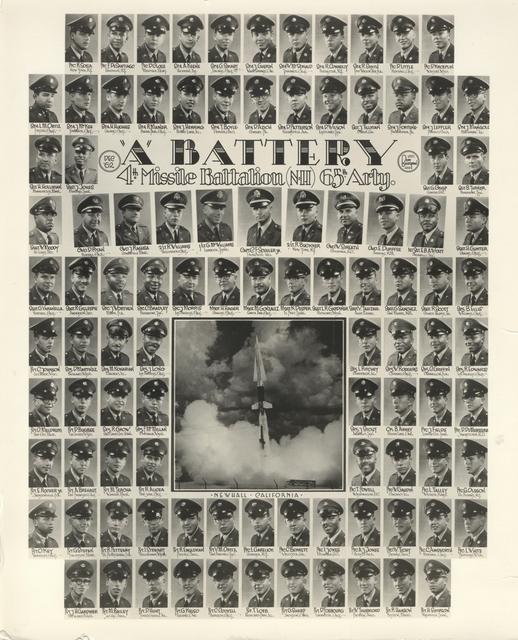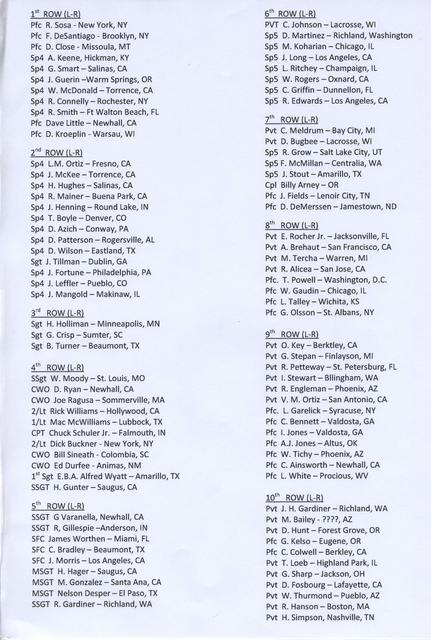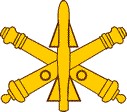Page by LT Dick Buckner Battery Commander
1 Feb 1963 to 10 Apr 1963
Award photo for SP5 Larry Ritchey
L-R LTC Charles Cole BNCO 4/65
1/LT Dick Buckner CO A/4/65
AGT Unknown
SP% L. Ritchey
COL Ray Murphy CO 47th Artillery BDE (Air Defense)
.
The End
Photo December 1962
FIRST ASSIGNMENT – “Defending” Los Angeles
Air Defense: 16 May 1962 to 15 August 1963
A Battery (Newhall CA) also known as LA 94 (Nike Hercules-nuclear and Nike Ajax-conventional)
4th Battalion, 65th Air Defense Artillery (Van Nuys, CA)
47th Artillery Brigade (Air Defense)
Fort MacArthur, San Pedro, California
Life in the Newhall-Saugus Military Community - In The Middle of Nowhere:
Battery Commander - Captain Chuck Schuler
Lt Mac McWilliams,
Lt Ron Rencurrel,
Lt Rick Williams
Lt Dick Buckner
Warrant Officers Ed Durfy
Warrant Officer Joe Ragusa
Warrant Officer Bill Sineath,
Cuban Missile Crisis (October 1962):
In the fall of 1962, during the Cuban missile crisis, the command was received from higher headquarters to bring the battery to a war-time footing –“Battle Stations”. On 22 October 1962 the Cuban missile crisis was just about coming to a head. As a result the Battery along with all other air defense units around the United Sates was brought to DEFCON 3 (an increased alert posture). The 22nd of October was also the date that President John F. Kennedy addressed the Nation indicating that any missile launched from Cuba would be regarded as an attack by the Soviet Union. During the course of the increased alert status, the Battery Command element was charged with verifying the “Battle Stations” command that was transmitted from Brigade headquarters and which then required orders from the IFC to the Launch area to bring the Nike Hercules (nuclear) missiles and the Nike Ajax missiles (high explosive) missiles out from under their cement bunkers into the ready-to-fire position. On 24 October there was another increase to DEFCON 2. At that time the Battery was given the order to go to autonomous operations which meant that we were authorized to launch a missile if we determined that there was an incoming threat that did not answer to our Identification Friend or Foe (IFF) request. To make sure that this response was immediate, the IFC gave the command for the launch area crew to connect the firing squibs to all of the missiles. This meant that all the IFC had to do was to lock on an incoming enemy aircraft and hit the launch switch for an intercept. Needless to say, the pucker factor was huge for a few hours. It was hard to believe the touch of a switch, could launch a nuclear missile in defense of Los Angeles. It was a relief to get the order from Brigade Headquarters to have the Battery stand down.
Change of Command:
On 31 January 1963 when CPT Schuler ended his tour of duty as the Commander of A Battery, Lt Dick Buckner was selected to assume command of the Battery.
Battery command was extremely challenging. Being called the “old man” at the ripe old age of 22 years was a bit overwhelming. I quickly learned the importance of having outstanding non-commissioned officers in critical positions.
One of the most horrific experiences I ever had during my short stint as the Battery Commander occurred when two of my outstanding enlisted men (Cpl Billy Arney and SP5 Rudy Queen) were involved in a car accident in the early morning hours of 14 March 1963. The accident took place on one of the roads near Piru, California. Both men were outstanding soldiers. Unfortunately Arney, who was driving the vehicle, was killed on impact when it collided with a tractor-trailer. A young girl who was in the vehicle during the collision was also killed. I was appointed the investigating officer and given the task to report the facts surrounding the death of Arney, the injury to Queen, and finally to recommend the “line of duty” status as it applied to both individuals. On 15 March I traveled to the scene of the accident and inspected the damage done to the tractor-trailer. The vehicle driven by Arney had already been towed from the scene of the accident. I then went to the morgue and was required to identify Arney’s body. It was one day in my 30-year Army career that I will never forget.
1st LT Dick Buckner
